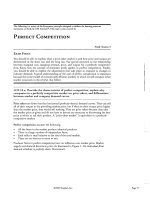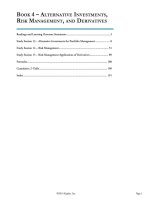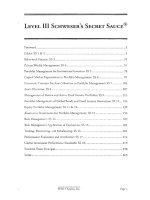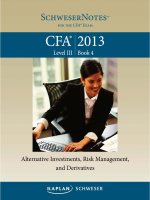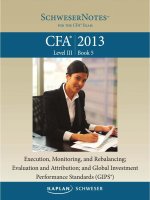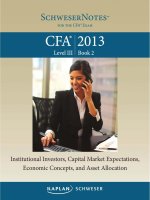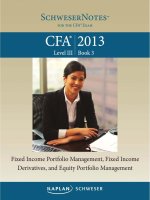2019 CFA level 3 qbank reading 19 principles of asset allocation questions
Bạn đang xem bản rút gọn của tài liệu. Xem và tải ngay bản đầy đủ của tài liệu tại đây (663.42 KB, 27 trang )
Question #1 of 37
Billy Kramer is deciding whether or not to add an emerging markets fund to his current 401k
which is broadly diversi ed among a mix of bond and equity funds. His current portfolio has an
expected return of 9% with a standard deviation of 10%. The emerging markets fund has an
expected return of 16%, a standard deviation of 21%, and a correlation of .74 with Kramer's
current portfolio. Assume the risk free rate is 3%. Given this information, should Kramer add
the emerging markets fund to his current portfolio?
A) No, since the emerging markets fund is adding signi cant risk and we don’t know how
.in
much risk Kramer can tolerate.
en
tre
B) No, since the correlation between the emerging markets fund and the current portfolio
is too high.
C) Yes, since adding the emerging markets fund to his current portfolio will result in a
Question #2 of 37
bo
ok
c
higher Sharpe ratio of the newly formed portfolio.
.o
allocation?
m
A bank is most likely to use which of the following approaches to liability-relative asset
w
w
A) Integrated asset-liability approach.
B) Two-portfolio approach.
w
C) Surplus e cient frontier approach.
Question #3 of 37
Melissa Brown, an analyst with Mollette Capital Advisors, is reviewing the client pro le of Karrie
Jones. Mollette manages all of Jones' investment assets; however, since Brown is new to the
rm, she has never met Jones. She does know, however, that Jones' asset allocation is
appropriate given her age and investment policy statement. The allocation of Jones' portfolio is
shown below:
Asset Class
Allocation (%)
Cash
5%
5%
U.S. equities
60%
International equities
30%
en
tre
High quality corporate bonds
.in
Intermediate-term Treasury bonds 0%
Given Jones' asset allocation, which of the following conclusions about Jones is most accurate?
A) Jones’ human capital makes up the bulk of her portfolio.
bo
ok
c
B) Jones has a low risk tolerance.
m
C) Jones has a large amount of nancial capital.
.o
Question #4 of 37
w
w
Which of the following asset classes is least likely to require a liquidity return premium?
A) Infrastructure.
w
B) Commodities.
C) Direct real estate.
Question #5 of 37
The following information is available regarding corner portfolios from an e cient frontier.
Asset Class Weights
Corner
Portfolio
Expected
Return
Exp. Std.
Dev.
1
6.90%
4.60%
0.00% 12.00% 88.00% 0.00%
2
10.00%
8.64%
0.00% 15.00% 45.00% 40.00%
3
13.00%
12.50%
55.00% 0.00% 45.00% 0.00%
1
2
3
4
A foundation has a spending rate of 8%. If in ation is expected to be 3.50% annually and the
cost of earning investment returns is 0.5%, which of the following represents the correct weight
.in
of one of the asset classes that will at a minimum satisfy the investor's goals of capital
A) Asset class 2 with weight of 50.00%.
B) Asset class 1 with a weight of 42.90%.
w
w
w
.o
m
Question #6 of 37
bo
ok
c
C) Asset class 3 with weight of 39.00%.
en
tre
preservation in real terms to an investor with a risk aversion value of 4?
Based on the following information, compute the weight of US bonds in an e cient portfolio
with an expected return of 12.50%?
The following are the long-term capital market expectations:
Correlations
Asset
Class
Expected
Return
Exp. Std.
Dev.
1
1
US Equity
12.00%
16.00%
1.00
2
US Bonds
8.25%
6.50%
0.32 1.00
3
Intl
Equities
14.00%
18.00%
0.46 0.22 1.00
4 Intl Bonds
9.25%
12.25%
0.23 0.56 0.32 1.00
5
11.50%
21.00%
0.25 0.11 0.08 0.06 1.00
4
5
.in
3
en
tre
Alt Inv
2
The details of each corner portfolio are given below.
Exp.
Std.
Dev.
Sharpe
Ratio
bo
ok
c
Corner Expected
Portfolio Return
Asset Class Weights
2
3
4
5
1
14.00%
18.00%
0.639
0.00%
0.00%
100.00% 0.00%
2
13.66%
16.03%
0.696
0.00%
0.00%
86.36%
0.00% 14.00%
3
13.02%
m
1
0.775
21.69% 0.00%
56.56%
0.00% 21.76%
4
12.79%
13.00%
0.792
21.48% 0.00%
52.01%
5.24% 21.27%
5
10.54%
8.14%
0.988
9.40% 51.30%
26.55%
0.00% 12.76%
8.70%
6.32%
0.981
0.00% 89.65%
4.67%
0.00%
.o
w
w
w
6
13.58%
A) 6.25%
B) 5.75%.
C) 6.67%.
Question #7 of 37
Any mean-variance e cient portfolio has the:
0.00%
5.68%
A) lowest standard deviation for a given level of expected return.
B) highest return among all other portfolios.
C) lowest standard deviation and the highest expected return.
Question #8 of 37
In context of portfolio rebalancing, if the correlation of the asset class with the rest of the
.in
portfolio is lower, then the optimal corridor of the asset class will be:
A) unchanged.
en
tre
B) narrower.
Question #9 of 37
bo
ok
c
C) wider.
Aaron Manning wishes to minimize the risk of his portfolio returns as measured by standard
m
deviation while meeting a minimum expected return objective. The risk-free rate is 2%. The
.o
following asset allocations are available:
Expected return Standard deviation of returns
12%
Allocation 2 7%
10%
Allocation 3 11%
15%
w
w
w
Allocation 1 10%
Based on the information provided, which of the following allocations should Manning choose?
A) Allocation 1
B) Allocation 2
C) Allocation 3
Question #10 of 37
Dan Laske is evaluating three portfolios for investment of his retirement funds. Laske has a risk
aversion value of 5. Which portfolio would be best for him?
Portfolio Return Std. Dev.
A
15.0%
17.0%
B
10.6%
10.0%
C
8.8%
8.0%
A) A.
B) B.
en
tre
.in
C) C.
Question #11 of 37
bo
ok
c
Which of the following methods is the most appropriate way of incorporating client risk
preferences into asset allocations?
A) Specify a risk tolerance factor.
m
B) Specify a diversi cation objective.
w
w
.o
C) Specify additional constraints.
w
Question #12 of 37
Shad Reed is on the Board of Trustees for the Wesley Ridge World Hunger Organization. The
primary role of the organization is to oversee a large endowment fund that was originally
established in 1995 as the Wesley Ridge U.S. Hunger Fund to provide food to low income
children in the United States. Recently, the original donor for the endowment has died and
provided the fund another $200 million in his will and broadened the scope of the fund to
provide food for hungry children all over the world. With the new addition, the endowment's
assets are currently valued at $600 million. When the fund was originally established, the
spending rate was 5%; however, with the broader scope, the payout has increased to 6%. Also,
since funds are going to be distributed to other countries, the board has determined that
approximately 25% of the foundation's annual payout will be in the foreign currencies of other
.in
countries. The fund's investment policy statement which has been revised by the board is
en
tre
shown below:
Accounting for in ation of 2.5% and the new spending
Return Objective rate of 6%, the return requirement for the plan is 8.5%. A
total return approach is appropriate.
Above average, although risk tolerance has declined due
to higher spending needs.
Liquidity
The endowment has minimal operating expenditures –
liquidity requirements are low.
Time Horizon
Long-term
m
Legal/Regulatory N/A
bo
ok
c
Risk Tolerance
Taxes
N/A
w
w
Unique
Considerations
.o
N/A
w
The board has consulted with an investment advisor to discuss changes to the endowment's
current asset allocation which is shown below:
Allocation
(%)
Expected
Return
Expected Standard
Deviation
Cash
2%
3.0%
2%
Intermediate-term U.S.
Treasury bonds
28%
5.5%
7%
Foreign Government Bonds
8%
6.5%
10%
U.S. equities
50%
9.5%
18%
Asset Class
International equities
7%
11.0%
23%
Venture Capital
5%
19.0%
38%
Which of the following sets of recommendations would be most appropriate for the
endowment fund?
A) Increase the allocation to cash, decrease the allocation to U.S. equities, decrease the
allocation to international equities, and increase the allocation to venture capital.
B) Decrease the allocation to U.S. Equities, decrease the allocation to international
equities, increase the allocation to foreign government bonds, and increase the
.in
ll
i
i
di
S
b d
C) Increase the allocation to foreign government bonds, increase the allocation to
international equities, keep the allocation to cash the same, and keep the allocation to
en
tre
i l h
w
w
w
.o
m
bo
ok
c
Question #13 of 37
Todd Zattau is the chief nancial o cer for the Crandall Steel Company, a mature U.S. steel
processing company. The company provides a traditional de ned bene t pension plan to all of
its employees. The plan covers 5,000 employees and the average age of workers who will
eventually collect bene ts is 52. Approximately 45% of the plan's participants are now retired
and are receiving bene ts. Zattau has hired Kara Rittenhouse, a nancial advisor to help him
construct an IPS for the plan as well as recommend revisions to the plan's current investment
allocation.
Zattau's progress on the IPS so far is shown below:
The discount rate applied to liabilities is 6.5%. Desired
level of returns is 7.2%.
Risk Tolerance
?
Liquidity
?
Time Horizon
Company is a going concern, and new employees are still
being added to the de ned bene t plan, so the actual
time horizon of the plan is in nite. However, the high
percentage of retired participants and older workforce
reduces the e ective time horizon of the plan
considerably.
bo
ok
c
en
tre
.in
Return Objective
Legal/Regulatory Plan is subject to ERISA requirements.
None
Unique
Considerations
Plan is currently underfunded by 4%.
w
w
.o
m
Taxes
The current investment allocation for the plan is shown below:
w
Asset Class
Allocation (%) Expected Return
Cash
3%
3.0%
Intermediate-term Treasury bonds
25%
5.0%
High quality corporate bonds
32%
5.5%
U.S. equities
10%
8.5%
International equities
10%
10.0%
Venture Capital
15%
19.0%
Based on the information provided, what is the risk tolerance for the Crandall Steel Pension
plan, and what should Rittenhouse recommend for the plan's allocation to cash and U.S.
equities respectively?
Risk Tolerance
Cash Allocation
U.S. Equities Allocation
A) Below Average
Higher
Higher
B) Above Average
Adequate
Higher
C) Below Average
Lower
Lower
w
w
w
.o
m
bo
ok
c
en
tre
.in
Question #14 of 37
Taylor Robinson, age 60, recently retired from her position as director of public giving for
United Electric Power, a large public utility company. Robinson has accumulated $2,000,000 in
her 401(k) portfolio for retirement. Robinson estimates that she will need $50,000 after-tax in
today's dollars to live comfortably. In ation is expected to be 2.5% annually. With her
background in public giving, Robinson has two favorite charities and would like to make non-tax
deductible gifts of $10,000 to each of them annually, indexed for in ation. In her will, Robinson
has speci ed that at her death, a gift fund will be established for each charity. Given this
objective, one of Robinson's primary goals is to maintain the principal in her retirement fund in
order to have a $1,000,000 gift account for each charity. Robinson recently met with her
nancial advisor, Brian Mitchell, CFA. During their meeting Robinson stated, "If I wanted to
.in
gamble with my investments, I would play blackjack. At least then I would have fun losing
Asset Class
Small cap U.S. stocks
International – Developed
market equities
Portfolio
A
Portfolio
B
Portfolio
C
5%
15%
25%
5%
bo
ok
c
Large cap U.S. stocks
en
tre
money." Mitchell presented Robinson with three di erent model portfolios.
10%
5%
15%
10%
15%
U.S. Corporate bonds
10%
50%
U.S. Treasury bonds
5%
20%
Hedge fund of funds
10%
Venture capital
15%
Cash
25%
10%
10%
Total expected after-tax return
5.8%
5.5%
6.0%
Current yield
1.4%
1.6%
1.8%
w
w
w
.o
m
International – Emerging market
equities
Which of the portfolios would be most appropriate for Robinson?
A) Portfolio C.
B) Portfolio A.
C) Portfolio B.
5%
30%
5%
Question #15 of 37
Which of the following statements regarding mean variance optimization (MVO) is least
accurate?
A) An individual with average risk tolerance will have a lamda of about 4.
B) Short positions are permitted.
.in
C) All asset weights add up to 100%.
en
tre
Question #16 of 37
Which of the following statements regarding risk and risk budgeting is correct?
bo
ok
c
A) Active risk is most relevant in an asset allocation implementation setting.
B) For risk budgeting purposes, risk can be de ned as total risk, active risk, or mis t risk.
C) An optimal risk budget minimizes the total amount of portfolio risk that is allocated to
.o
m
the portfolio’s constituent parts.
w
w
Question #17 of 37
Which of the following statements regarding factor-based asset allocation is correct?
w
A) The factors may be highly correlated with the market portfolio.
B) The value-growth factor is the combined return from a short position in growth stocks
and a long position in value stocks.
C) The size factor is the combined return from a short position in small stocks and long
position in large stocks.
Question #18 of 37
Corri Morgan is an investment advisor for Izaguirre Investment Management (IIM). Morgan is
reviewing the account for Brian and Nicole Herbster.
Brian and Nicole are both age 65, and have one daughter, Andrea, age 18. The Herbsters are
recently retired from Tucker Technology Inc., a large manufacturer of microprocessors for a
variety of applications. Andrea is an aspiring nance student and would like to attend a
prestigious university to pursue a degree in nance. The tuition at the University costs $40,000
per year, but Andrea's strong academic performance in high school allowed her to earn a
scholarship covering half of the tuition. The Herbsters have expressed a desire to fund the
amount of the college education not covered by the scholarship, as well as leave a large
inheritance to Andrea at their death. During their careers, the Herbsters earned relatively high
.in
incomes, and were able to save approximately 10% of their income each year. With regard to
their portfolio, they say they prefer investments that have minimal volatility. Their current
en
tre
investment portfolio is valued at $1.2 million.
The investment policy statement for the Herbsters is shown below:
The Herbster's income requirement is $6,000 monthly.
Total return requirement is $72,000 / $1,200,000 = 6%.
Risk Tolerance
Ability to take on risk: average. Willingness to take risk:
below average
Liquidity
Need cash each year for the next four years to fund
college education.
Time Horizon
3 stages. Stage 1, funding daughter's college tuition. Stage
2, retirement. Stage 3, after death – inheritance for
daughter.
w
w
.o
m
bo
ok
c
Return Objective
Legal/Regulatory N/A
w
Taxes
Unique
Considerations
Little need to defer income.
Desire to fund daughter's college education.
The Herbster's current portfolio is shown below:
Asset/Fund
Allocation Expected Expected
(%)
Return
Yield
Expected
Standard
Deviation
Tucker Technology
Common Stock
32%
19.0%
0.5%
28%
Money Market Fund
2%
2.5%
2.5%
2%
Diversi ed Bond
Fund
30%
6.5%
5.5%
8%
Large capitalization
equities
15%
9.5%
2.0%
16%
Emerging market
equities
15%
16.0%
1.0%
26%
Undeveloped
commercial land
6%
19.0%
0%
N/A
After reviewing the notes on the Herbster's, Morgan reviews recommendations complied by
.in
Todd Irons, a fellow portfolio manager with IIM. Irons' recommendations include the following:
Recommendation 2:
Increase the allocation to the Diversi ed Bond Fund in
order to increase income and decrease volatility.
Recommendation 3:
Increase the allocation to Large Capitalization Equities
to provide growth.
Recommendation 4:
Maintain the allocation to emerging market equities
due to their high returns.
Recommendation 5:
Maintain the allocation the undeveloped commercial
land due to its low correlation with other assets in the
portfolio.
w
w
.o
m
bo
ok
c
en
tre
Recommendation 1:
Reduce the weighting in Tucker Technology common
stock – the large position exposes the portfolio to
unnecessary security speci c risk.
After reviewing Irons' recommendations, Morgan should agree with:
w
A) Recommendations 1, 2 and 3 only.
B) Recommendations 1, 2 and 4 only.
C) Recommendations 1, 3 and 5 only.
Question #19 of 37
The following information is available regarding corner portfolios from an e cient frontier.
Corner
Portfolio
Expected
Return
Exp.
Std.
Dev.
Sharpe
Ratio
1
1
9.90%
6.60%
1.197
0.00%
11.10% 88.90% 0.00%
2
10.06%
6.64%
1.214
0.00%
14.90% 85.10% 0.00%
3
12.10%
9.58%
1.054
55.22%
0.00% 44.78% 0.00%
4
14.23%
14.74%
0.830
100.00%
0.00%
Asset Class Weights
2
3
0.00%
4
0.00%
.in
An investor has a spending rate of 6%. If in ation is expected to be 4.50% annually and the cost
of earning investment returns is 0.5%, what would be the utility of the portfolio that will at a
en
tre
minimum satisfy the investor's goals of capital preservation in real terms with a risk aversion
value of 4?
B) 0.099.
C) 0.120.
.o
m
Question #20 of 37
bo
ok
c
A) 0.078.
Andrew Tyson, age 31, has an existing investment portfolio consisting of investment grade
w
w
bonds and large cap stocks. He also owns an apartment unit in the city and has a stable and
promising career as an engineer. By including his apartment and his human capital in his
w
investment portfolio, his capacity to bear risk would most likely:
A) increase.
B) remain unchanged.
C) decrease.
Question #21 of 37
Daniel Roe and Loretta Morgan are both potential new clients of Grachek Investment Advisors.
A summary of Ellen Grachek's notes concerning the potential clients are as follows:
Roe stated that he wants to have a positive return on his $500,000 portfolio at all times,
and that his required before-tax return is 7%. On a risk aversion questionnaire, Roe
scored an 8, with 10 indicating the highest risk aversion.
Morgan indicated that her $1,000,000 portfolio must generate a 2% return each year in
order to meet her living expenses without making any withdrawals from the portfolio's
principal. On a risk aversion questionnaire, Morgan scored a 3, with 10 indicating the
highest risk aversion.
en
tre
Characteristics for each portfolio are identi ed below:
.in
Grachek Investment Advisors has four model portfolios that they use for each client.
Portfolio Expected Return Standard Deviation
5.5%
7%
B
6.0%
8%
C
6.5%
10%
D
8.0%
bo
ok
c
A
15%
After reviewing her notes and making some calculations, Grachek makes the following
.o
Based on a utility adjusted return of 2.54%, Portfolio B
would be the best choice for Roe.
Using Roy's Safety-First Measure, Portfolio D generates
a score of 0.40, and would be the worst choice of the
four for Morgan's portfolio.
w
w
Statement 1:
m
statements regarding each client:
w
Statement 2:
Regarding Gracket's statements:
A) Statement 1 is incorrect; Statement 2 is incorrect.
B) Statement 1 is correct; Statement 2 is correct.
C) Statement 1 is incorrect; Statement 2 is correct.
Question #22 of 37
Which of the following statements regarding the two-portfolio (or the hedging/return-seeking)
approach to liability-relative asset allocation is correct?
A) The hedging portfolio could be constructed using cash ow matching.
B) If the funding ratio is greater than 1, then it becomes di cult to create a hedging
portfolio that completely hedges the liabilities.
C) The asset allocation decisions regarding the two portfolios are made in conjunction with
.in
each other.
w
w
w
.o
m
bo
ok
c
en
tre
Question #23 of 37
Based on the following information, which asset class is the most signi cant in an e cient
portfolio with an expected return of 12.50%?
The following are the long-term capital market expectations:
Correlations
Asset
Class
Expected
Return
Exp. Std.
Dev.
1
1
US Equity
12.00%
16.00%
1.00
2
US Bonds
8.25%
6.50%
0.32 1.00
3
Intl
Equities
14.00%
18.00%
0.46 0.22 1.00
4 Intl Bonds
9.25%
12.25%
0.23 0.56 0.32 1.00
5
11.50%
21.00%
0.25 0.11 0.08 0.06 1.00
4
5
.in
3
en
tre
Alt Inv
2
The details of each corner portfolio are given below. The risk free rate is assumed to be equal
bo
ok
c
to the T-bill rate of 2.5%. Using margin is not allowed.
Exp.
Std.
Dev.
Sharpe
Ratio
1
2
Asset Class Weights
3
4
5
14.00%
18.00%
0.639
0.00%
0.00%
100.00% 0.00%
2
13.66%
16.03%
0.696
0.00%
0.00%
86.36%
0.00% 14.00%
3
13.02%
13.58%
0.775
21.69% 0.00%
56.56%
0.00% 21.76%
4
12.79%
13.00%
0.792
21.48% 0.00%
52.01%
5.24% 21.27%
10.54%
8.14%
0.988
9.40% 51.30%
26.55%
0.00% 12.76%
8.70%
6.32%
0.981
0.00% 89.65%
4.67%
0.00%
w
6
w
w
5
.o
1
m
Corner Expected
Portfolio Return
A) International equity with a weight of 48.70%.
B) Alternative investments with a weight of 20.17%.
C) International equity with a weight of 45.51%.
Question #24 of 37
0.00%
5.68%
The investment committee of a life insurance company recommends a strategic asset allocation
for the company based on the projected policy premium in ows and payouts along with longterm capital market expectations. This approach to strategic asset allocation is known as the:
A) investment policy statement approach.
B) static approach.
C) asset-liability approach.
w
w
w
.o
m
bo
ok
c
en
tre
.in
Question #25 of 37
Cecil Boller is the portfolio manager for a $500 million de ned bene t pension fund. Boller has
been conducting a great deal of analysis to select the appropriate allocation for the fund. He
has come up with the following long-term expectations for various asset classes.
Asset Class
Expected
Return
Expected
Standard
Deviation
1
Correlations
2
3
4
U.S. equity
12.00%
16.00%
1.00
2
U.S. corporate
bonds
8.25%
6.50%
0.32 1.00
3
Int'l equities
14.00%
18.00%
0.46 0.22 1.00
4
Int'l bonds
9.25%
12.25%
0.23 0.56 0.32 1.00
5
Alternative
Investments
11.50%
21.00%
en
tre
.in
1
5
0.25 0.11 0.08 0.06 1.00
Based on these expectations, Boller identi es an e cient frontier with four corner portfolios
bo
ok
c
with the characteristics shown below. The risk-free rate is assumed to be equal to the T-bill rate
of 3.0%.
1
2
3
4
5
0.611
0%
0%
100%
0%
0%
16.03%
0.665
0%
0%
86.36%
0%
13.64%
12.79%
13.00%
0.753
21.48% 0.00% 52.01% 5.24% 21.27%
10.54%
8.14%
0.926
9.40% 51.30% 26.55%
14.00%
2
13.66%
w
w
0%
w
4
18.00%
.o
1
3
Asset Class Weights
m
Expected
Corner Expected
Sharpe
Standard
Portfolio Return
Ratio
Deviation
Boller has determined that the fund has a spending rate of 7.5%. In ation is expected to be
2.5% per year, and the cost of managing the fund is expected to be 0.50%. The expected return
on the portfolio is therefore (1.075)(1.025)(1.005) – 1 = 10.74%. Boller has also stated that he
does not want the standard deviation of the pension portfolio to exceed 9.0% and there is a
constraint against short selling.
Conclusion 1:
The weight given to U.S. equity in the pension portfolio
should be greater than 11.0%.
Conclusion 2:
The weight given to corporate bonds in the portfolio
should be exactly 30.78%.
12.76%
Conclusion 3:
The weight given to alternative investments in the
portfolio should be greater than 13.0%.
Given this information, which of the following conclusions drawn by Boller are CORRECT?
A) Conclusion 3 only.
B) Conclusions 1 and 3 only.
C) Conclusions 1 and 2 only.
.in
Question #26 of 37
en
tre
Which of the following heuristic and other approaches to asset allocation is most
closely associated with the assumption of a lack of informationally e cient markets?
A) 60/40 stock/bond heuristic
bo
ok
c
B) Norway model
m
C) Endowment model
.o
Question #27 of 37
w
w
Following information is a partial list of corner portfolios:
w
Portfolio Exp. Return Std. Dev.
Asset class weights
1
2
3
1
12.00%
10.50%
65.00% 0.00% 35.00%
2
16.50%
14.00%
15.00% 20.00% 50.00%
3
18.00%
20.00%
30.00% 20.00% 25.00%
4
23.00%
24.00%
15.00% 20.00% 55.00%
Which asset class is the most signi cant for an e cient portfolio with an expected return of
15% and the approximate standard deviation of this e cient portfolio?
A) Asset class 2, 12.85%.
B) Asset class 1, 15.00%.
C) Asset class 3, 12.85%.
Question #28 of 37
Which of the functions is least likely to be addressed with Monte Carlo simulation?
A) Assisting individual investors in identifying risk tolerance levels
B) Rebalancing and taxes of a portfolio in a multi-period framework
en
tre
.in
C) Transforming a data set with a non-normal distribution to a normal distribution
Question #29 of 37
bo
ok
c
David Jalbert is considering three potential asset allocations. He wishes to earn a nominal
return no less than 2% as he has a low risk tolerance with a lamda of 7.
The following asset allocations are available:
Allocation 1 5%
.o
Allocation 2 7%
m
Expected return Variance
w
w
Allocation 3 9%
0.0100
0.0143
0.0200
w
Based on the information provided, which of the following allocations should Jalbert choose?
A) Allocation 1.
B) Allocation 2.
C) Allocation 3.
Question #30 of 37
Je Graefe has a risk-aversion value of 6. He is evaluating three competing investments with the
following characteristics. Which investment would have the least utility for Graefe?
Portfolio Return Std. Dev.
A
18.0%
24.0%
B
13.5%
10.0%
C
9.5%
6.0%
A) A.
B) B.
en
tre
.in
C) C.
Question #31 of 37
bo
ok
c
Frances Bonner, a retired nurse, is a potential new client for Fullen Capital Management.
Bonner has told Fullen that in order to pay the living expenses not covered by her pension and
social security, she must generate $10,000 annually on her $500,000 investment portfolio. She
does not want to use principal to meet her living expenses. Fullen has four model portfolios
m
that Bonner could use for her portfolio.
B
w
C
4.5%
6%
5.5%
8%
6.5%
10%
w
w
A
.o
Portfolio Expected Return Standard Deviation
Based on Roy's Safety-First Measure, Bonner should select:
A) Portfolio B.
B) Portfolio A.
C) Portfolio C.
Question #32 of 37
Which of the following statements regarding liabilities in the context of the asset allocation
decision is correct?
A) The pension liability associated with a de ned pension plan is an example of a xed
liability.
B) A university endowment contribution is an example of a legal liability.
C) A small pension liability in relation to the size of the sponsoring organization should be
.in
ignored.
en
tre
Question #33 of 37
Which of the following statements regarding the goals-based approach to asset allocation is
correct?
A) Individuals are often concerned with single goals while institutions are often concerned
bo
ok
c
with multiple goals.
B) The relevant risk measure for both individuals and institutions is the probability of
missing the goal.
C) The return determination for individuals is based on minimum expectations while for
w
w
.o
m
institutions, it is based on mathematical expectations.
w
Question #34 of 37
Based on the following information, and using a weighted average of the corner portfolios that
bracket the return objective, compute the weight of US bonds in an e cient portfolio with an
expected return of 13.50%.
The following are the long-term capital market expectations:
Correlations
Asset
Class
Expected
Return
Exp. Std.
Dev.
1
1
US Equity
12.00%
16.00%
1.00
2
US Bonds
8.25%
6.50%
0.32 1.00
3
Intl
Equities
14.00%
18.00%
0.46 0.22 1.00
4 Intl Bonds
9.25%
12.25%
0.23 0.56 0.32 1.00
5
11.50%
21.00%
0.25 0.11 0.08 0.06 1.00
4
5
.in
3
en
tre
Alt Inv
2
bo
ok
c
The details of each corner portfolio are given below.
Exp.
Std.
Dev.
Sharpe
Ratio
1
2
Asset Class Weights
3
4
5
14.00%
18.00%
0.639
0.00%
0.00%
100.00% 0.00%
2
13.66%
16.03%
0.696
0.00%
0.00%
86.36%
0.00% 14.00%
3
13.02%
13.58%
0.775
21.69% 0.00%
56.56%
0.00% 21.76%
4
12.79%
13.00%
0.792
21.48% 0.00%
52.01%
5.24% 21.27%
10.54%
8.14%
0.988
9.40% 51.30%
26.55%
0.00% 12.76%
8.70%
6.32%
0.981
0.00% 89.65%
4.67%
0.00%
w
6
w
w
5
.o
1
m
Corner Expected
Portfolio Return
A) 6.25%.
B) 3.75%.
C) 0.00%.
Question #35 of 37
0.00%
5.68%
